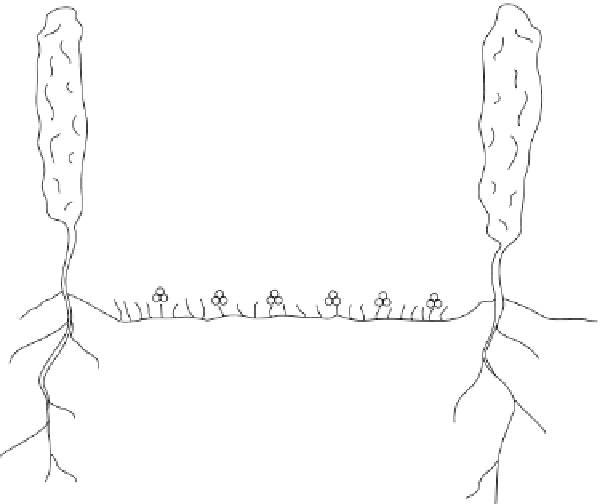Agriculture Reference
In-Depth Information
CO
2
in the
atmosphere
Leaf fall,
prunings
C inputs in
manure, compost,
mulch
Cover crop
residues
CO
2
CO
2
Incorporation
by soil organisms
C in soil organic
matter and soil
biomass
Root
respiration
and decay
Figure 5.1
Carbon (C) flows in the C cycle of a vineyard. Inputs to the soil and vines, solid
arrows; outputs as carbon dioxide (CO
2
), dashed arrows.
When digesting and decomposing C substrate derived from litter and in the soil
proper, organisms obtain energy and essential nutrients for growth. In so doing, in a
healthy soil, they consume oxygen (O
2
) and release carbon dioxide (CO
2
) to the air
below and above ground, thus completing the C cycle. Directly analogous to the pro-
cess described for nitrogen (N) in chapter 3, C is said to be immobilized in the bodies
of the soil organisms and mineralized when it is released as CO
2
. The proportion of C
substrate that is mineralized as CO
2
in one cycle of decomposition varies among the
main groups of organisms, but the average for the whole soil is about 50%.
Individual organisms inevitably die and form the substrate for succeeding
generations, which continue to decompose “old” and “new” substrates and release
CO
2
. The overall effect is a cascade of decomposition, with CO
2
being released and
organic matter steadily being transformed into more and more recalcitrant residues
(figure 5.2). The combination of living microorganisms and dead organic matter,
excluding living plant roots and soil animals, is called soil organic matter (SOM).
Carbon Turnover in Soil
Steady-state equilibrium for soil C is reached when the annual input of C in
organic residues above and below ground just balances the annual losses. These
losses occur through decomposition, soil erosion, and some leaching of dissolved





















